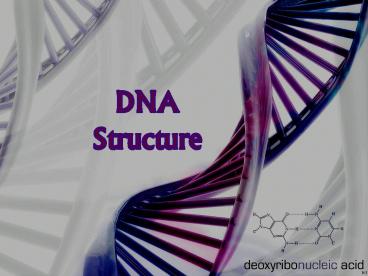Chapter 12: DNA and RNA - PowerPoint PPT Presentation
1 / 11
Title:
Chapter 12: DNA and RNA
Description:
DNA Deoxyribonucleic acid DNA is a biological polymer Made up of subunits called nucleotides Each nucleotide is made up of a sugar, a phosphate and a base Nucleotide ... – PowerPoint PPT presentation
Number of Views:1900
Avg rating:3.0/5.0
Title: Chapter 12: DNA and RNA
1
DNA Structure
2
DNA
- Deoxyribonucleic acid
- DNA is a biological polymer
- Made up of subunits called nucleotides
- Each nucleotide is made up of a sugar, a
phosphate and a base
3
Nucleotide
- Nucleotide- Individual unit of DNA.
- Made of three parts
- Deoxyribose (5-carbon sugar)
- Phosphate group
- A nitrogen-containing base
4
- The phosphate and sugar form the backbone of the
DNA molecule, whereas the bases form the rungs.
5
Bases
- Four nitrogen-containing bases
- Adenine
- Guanine
- Cytosine
- Thymine
6
Bases
- Adenine
- double ringed
- Guanine
- Thymine
- single ringed
- Cytosine
purines
pyrimidines
7
Base Pairing Rule
- Bases are paired together in specific manner
- Because of chemical structure and shape
- Adenine only pairs with Thymine
- Guanine only pairs with Cytosine
- Exactly enough room for only one purine and
one pyramide base between the two strands of
DNA
8
Base Pairing Rule
- Bases held together in rungs by weak hydrogen
bonds - 2 hydrogen bonds between A T
- 3 hydrogen bonds between C G
9
DNA
10
DNA Double Helix
- DNA is made of two nucleotide strands that wrap
around each other in the shape of a double helix.
11
- Bonds Hold DNA Together
- Nucleotides along each DNA strand are linked by
covalent bonds. - Complementary nitrogenous bases are bonded by
hydrogen bonds. - Hydrogen bonding between the complementary base
pairs, G-C and A-T, holds the two strands of a
DNA molecule together. - Because of this complementary base pairing, the
order of the bases in one strand determines the
order of the bases in the other strand.































